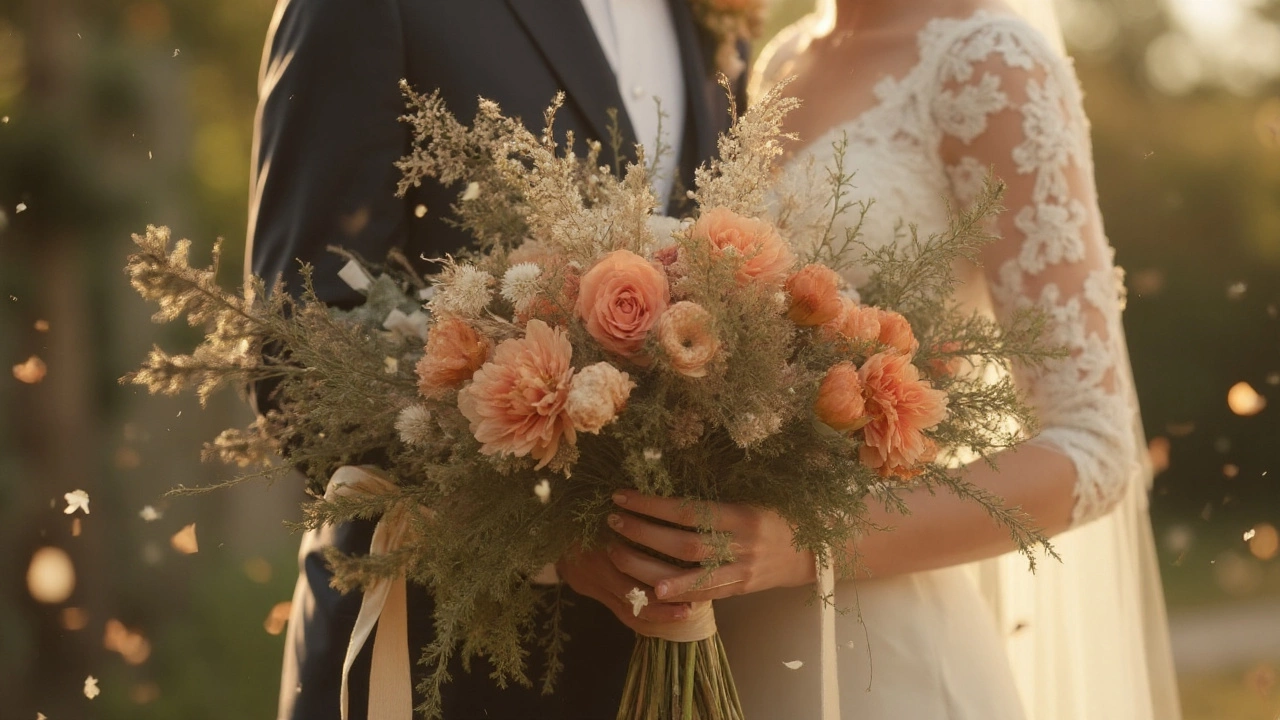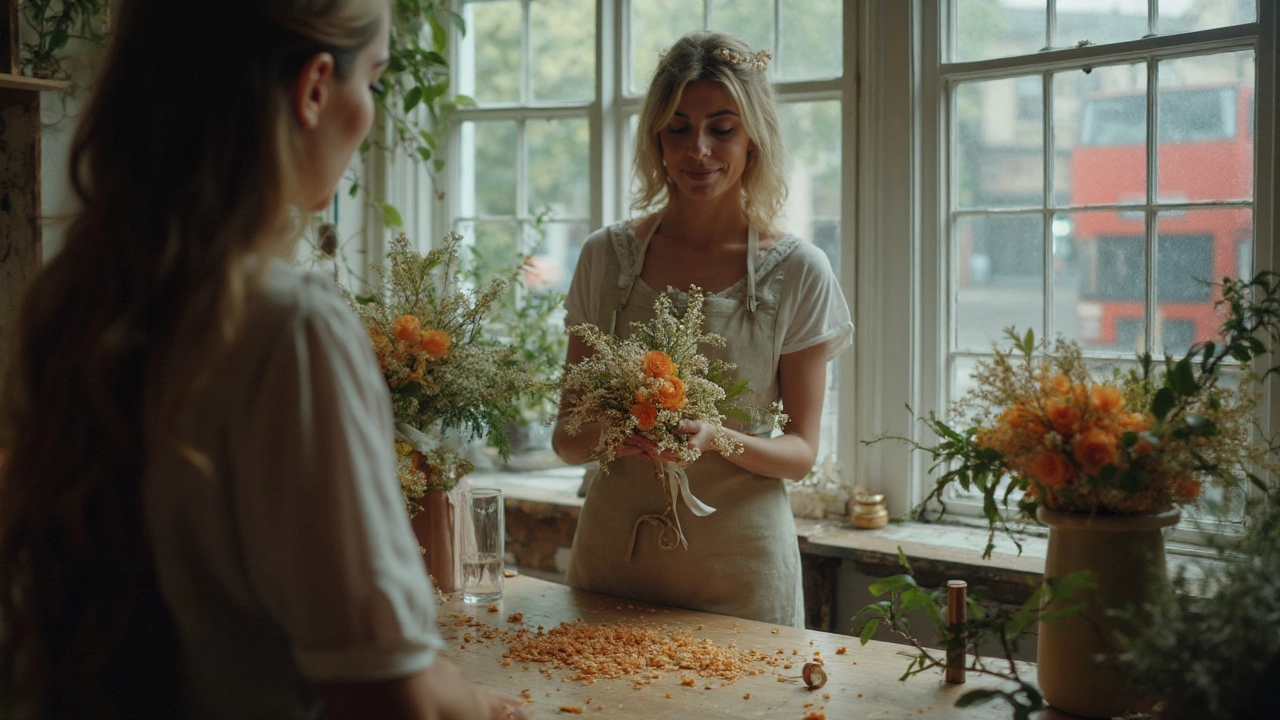You hear “wedding flowers” and think roses, right? Sweet, but history points to orange blossom as the original marriage icon-Victorian brides wore it, royals adored it, and perfumers still bottle it as the scent of vows. The catch: there isn’t just one right answer. Different cultures and eras crowned different blooms as the wedding flower, from stephanotis to myrtle. Here’s the short, straight answer-and the detail you need to choose the right symbol for your day.
Orange blossom is a fragrant citrus flower that has symbolized marriage, purity, and fertility since the 19th century. Traditionally from bitter orange (alternate name: Citrus × aurantium), it was popularised by Queen Victoria in 1840 and remains shorthand for “bride”.Citrus blossom
TL;DR
- Classic answer: orange blossom = marriage, purity, and fertility (Victorian to modern perfumery).
- Close contenders: stephanotis (“wedding flower”), myrtle (royal bouquets), lily of the valley (return of happiness), white rose (unity).
- Cultural icons: jasmine and marigold (South Asia), peony (East Asia), orchids (tropical elegance).
- In Australia: peonies peak Nov-Dec; lily of the valley is scarce; roses and orchids are steady; jasmine fragrant but seasonal.
- Pick by meaning + season + scent + budget. Use substitutes (mock orange, gardenia) if orange blossom isn’t available.
What flower symbolizes a wedding?
If you want a single, time-tested symbol, orange blossom is it. In the language of flowers (floriography), it stood for a blessed union. Queen Victoria wore an orange blossom wreath in 1840, and brides followed for decades. The Royal Horticultural Society notes its long association with bridal wear and fragrance. Many modern florists still reference orange blossom as “the marriage flower,” even when they can’t source the real thing and use lookalikes like mock orange or gardenia.
That said, wedding symbolism isn’t monolithic. Florists and historians often put stephanotis and myrtle in the same tier. Let’s quickly define the big three you’ll hear most:
Stephanotis is a waxy white blossom (alternate name: Stephanotis floribunda, sometimes sold as “Madagascar jasmine”) long nicknamed the “wedding flower” for its meaning: marital happiness and fidelity. It’s often wired into bouquets because the florets are delicate.Madagascar jasmine
Myrtle is a glossy-leaved herb (alternate name: Myrtus communis) symbolizing love and marriage since antiquity. British royal bouquets have included myrtle since 1858, grown from a cutting of Queen Victoria’s bush at Osborne House.Myrtus communis
Those three anchor the symbolism in Western traditions. But white roses, lily of the valley, and peonies carry strong “happy marriage” messages too, and they’re far easier to source. That’s where a practical approach helps: choose the meaning you love, then balance season, scent, and budget.
How to choose your symbolic wedding flower (without headaches)
- Meaning first: Decide what you want your flowers to say-purity (orange blossom), lasting love (myrtle), marital joy (stephanotis), fresh beginnings (lily of the valley), unity (white rose).
- Season and place: In Australia, peonies peak Nov-Dec; jasmine is late spring-summer; lily of the valley is rare; roses, orchids, and chrysanthemums are consistent year-round through imports.
- Scent and allergies: Orange blossom, jasmine, and lily of the valley have strong perfume. If your venue is scent-sensitive, use minimal scented blooms near dining areas and bulk out with textural greens.
- Budget: Use hero stems sparingly. Fill with baby’s breath, stock, snapdragons, or seasonal natives (e.g., waxflower) to keep costs steady.
- Supply reality: True orange blossom is seldom sold as cut stems. Ask for mock orange (Philadelphus), gardenia, or even orange blossom perfume on silk ribbon to nod to the tradition.
Meanings and must-knows for the major wedding flowers
Lily of the valley is a dainty bell-flower (alternate name: Convallaria majalis) meaning “return of happiness.” Loved by royals and minimalists. It bruises easily, needs hydration, and is premium-priced in Australia.Convallaria majalis
White rose is a classic rose (alternate name: Rosa, white cultivars) symbolizing unity, loyalty, and new beginnings. Readily available, broad price range, and sturdy in heat when conditioned well.Rosa (white cultivars)
Peony is a lush spring flower (alternate name: Paeonia lactiflora) associated with happy marriage, prosperity, and good fortune in East Asian traditions. Short season in Australia (mainly Nov-Dec), high-impact focal bloom.Paeonia lactiflora
Jasmine is a powerfully scented vine flower (common species: Jasminum sambac/grandiflorum) symbolizing divine love and auspicious beginnings across South Asia. Often woven into garlands for Hindu and Muslim ceremonies.Jasminum sambac
Marigold is a bold pom-pom bloom (alternate name: Tagetes erecta) representing auspiciousness, energy, and sun-blessed fortune in Indian weddings. Durable in heat, excellent for mandap decor and doorways.Tagetes erecta
Two more that solve real-world problems: baby’s breath and orchids.
Baby’s breath (Gypsophila paniculata) symbolizes everlasting love and purity. It’s feather-light, cheap per stem, and creates clouds of texture. Orchids (Phalaenopsis, Dendrobium) read as luxury, hold up in heat, and signal refined elegance in modern arrangements. They might not scream “marriage” linguistically, but they nail “timeless wedding vibe.”
Australia-specific availability, season, and price ranges (2025)
Here’s the on-the-ground view from Sydney florists this year. Prices vary by grade and week; think of these as typical retail ranges per stem (or per floret/garland where noted):
| Flower | Symbolism | Scent level | Main AU season | Heat durability | Typical price (AUD) | Notes |
|---|---|---|---|---|---|---|
| Orange blossom / mock orange | Marriage, purity, fertility | High (true orange), medium (mock) | Late spring (limited cut supply) | Low-medium | Varies (often special order) | Often substituted with mock orange or gardenia |
| Stephanotis | Marital happiness | Medium | Spring-summer | Medium | $2-$4 per floret | Usually wired; sold as florets or vines |
| Myrtle | Love, marriage | Low | Year-round (foliage) | High | $10-$18 per bunch | Used as greenery; hardy and symbolic |
| Lily of the valley | Return of happiness | High | Late winter-spring (scarce) | Low | $8-$15 per stem | Premium and fragile; needs careful conditioning |
| White rose | Unity, loyalty | Low-medium | Year-round | High | $3-$6 per stem | Best value workhorse; many varieties |
| Peony | Happy marriage, prosperity | Low-medium | Nov-Dec peak | Medium | $8-$12 per stem | Short season; book early for summer weddings |
| Jasmine | Divine love, auspicious start | High | Late spring-summer | Medium | $15-$30 per garland | Common as garlands for South Asian ceremonies |
| Marigold | Auspiciousness, brightness | Low | Spring-autumn | High | $10-$20 per bunch | Great for heat, colour blocks, and strings |
| Baby’s breath | Everlasting love, purity | Low | Year-round | High | $1-$2 per stem | Budget-friendly filler with airy volume |
| Orchid (Phalaenopsis) | Refined elegance | Low | Year-round (import/local) | High | $7-$12 per stem | Heat-tolerant, modern bridal favourite |

Culture matters: wedding flowers by tradition
Symbols shift by culture, and weddings reflect that.
- Mediterranean and Victorian: Orange blossom crowned marriage, purity, and fertility. It showed up in wax replicas on tiaras and in boutonnières when fresh wasn’t available.
- British royal tradition: Myrtle in the bouquet since 1858. The sprig is a quiet constant, even when the bouquet style changes.
- South Asian weddings: Jasmine and marigold are everywhere-garlands, mandaps, swing décor-signalling auspicious blessings and divine love.
- East Asia: Peony is a status symbol and a wish for a happy, prosperous union-common in spring bridal photos, stationery, and reception arrangements.
- Nordic/European forests: Lily of the valley and woodland elements (ferns, moss) carry “fresh start” energy and intimacy.
So if a guest asks, “What flower symbolizes a wedding?” you can say: orange blossom historically; stephanotis and myrtle traditionally; regional icons like jasmine, marigold, and peony culturally.
Real-world combos that nail the meaning (and the look)
- Classic white bridal: White roses + lily of the valley + myrtle. Meaning: unity, happiness, and marriage itself. Works in cool or warm venues; keep lily of the valley hydrated till last minute.
- Modern luxe: Phalaenopsis orchids + garden roses + ruscus. Meaning: elegant love story. Durable for summer photos and rooftop terraces.
- Summer garden party: Stephanotis florets wired into a rose bouquet, with mock orange foliage for scent. Meaning: marital happiness + the orange blossom nod without the sourcing drama.
- South Asian sangeet: Marigold strings + jasmine garlands + roses. Meaning: auspicious joy with romantic accents. Heat-proof and photogenic.
- Peony season romance (Nov-Dec AU): Coral or white peonies + sweet pea + myrtle. Meaning: prosperity and marriage, with soft movement for aisle shots.
Symbolism vs. logistics: quick decision guide
If you love tradition but need as-stress-free-as-possible planning, use this:
- Pick your core message. If it’s marriage itself, go orange blossom, stephanotis, or myrtle. If it’s joy and new beginnings, lily of the valley. If it’s prosperity + romance, peony. If you want the universal read: white roses.
- Check the date and temperature. Summer rooftop in Sydney? Choose orchids/roses over fragile lilies of the valley. Spring garden? Add stephanotis or jasmine for scent.
- Set a hero bloom and supporting cast. One symbolic flower as the “lead,” two to three hardy fillers and greens to carry shapes and volume.
- Mind scent zones. Strongly perfumed blooms near the altar, not the dining tables. Keep allergy-prone guests comfortable.
- Have a plan B. If orange blossom isn’t available, use mock orange, gardenia, or a vintage wax orange-blossom hairpiece for the look and meaning.
Authoritative roots for these meanings
These associations aren’t fluff. Florists pull from historical sources like Victorian floriography dictionaries, records from the Royal Horticultural Society, and royal wedding bouquet lists archived by the Royal Collection. Cultural meanings-like marigold and jasmine in Indian weddings or peony in Chinese celebrations-come from long-standing religious and social customs recorded by cultural studies scholars and horticultural societies.
Related concepts you’ll likely care about next
- Floriography (language of flowers): the 19th-century code behind many wedding flower meanings.
- Bouquet styles: hand-tied, cascade, pageant-your symbolic choice needs the right structure.
- Colour symbolism: white (purity), blush (tenderness), red (passion), gold (prosperity).
- Native Australian fillers: waxflower, kangaroo paw (for texture and durability alongside symbolic stems).
- Sustainable sourcing: seasonal picks, foam-free mechanics, and reusable vessels for eco-minded couples.
One last note: if you care deeply about wedding flower symbolism but can’t get the literal bloom, it’s okay. Use a symbolic sprig in the boutonnière, a tiny cluster in the bouquet, or even a charm on the ribbon. Meaning travels well in small doses.

Frequently Asked Questions
Is orange blossom actually available as a cut flower?
Rarely. True orange blossom (from bitter orange) is hard to source as cut stems in Australia. Florists often substitute mock orange (Philadelphus) or gardenia for a similar look and scent. Another option: use a vintage or silk orange-blossom hairpiece-very Victorian and still true to the symbol of marriage.
What’s the difference between stephanotis and jasmine?
Stephanotis floribunda is its own species, not a true jasmine, though it’s sometimes sold as “Madagascar jasmine.” It has thicker, waxy petals and is wired into bouquets as individual florets. True jasmine (like Jasminum sambac) comes in clusters and is often used in garlands with a stronger perfume. Both read “wedding,” but stephanotis is the Western “wedding flower,” while jasmine is iconic in South Asian ceremonies.
Why do royal bouquets have myrtle?
It’s a tradition dating to 1858, when a sprig from Queen Victoria’s myrtle at Osborne House was included in a royal bouquet. Since then, British royal brides have carried myrtle to symbolize love and marriage. It’s subtle, hardy greenery with a big story packed into a few leaves.
Are lilies of the valley worth the cost and fragility?
If “return of happiness” is the message you love and you want a small, elegant bouquet, yes. They’re premium and delicate, so keep stems cool, add them last, and plan for backups. If you need durability in summer heat, use a few stems for meaning and anchor the bouquet with roses or orchids.
What’s a good budget-friendly symbolic bouquet?
Start with white roses (unity), add a sprig of myrtle (marriage), and build volume with baby’s breath (everlasting love). You get clear symbolism, airy texture, and reliable stems without premium pricing.
Which flowers hold up best in hot Australian weather?
Orchids, roses, chrysanthemums, and tropical greens handle heat well. Peonies and lily of the valley need extra care. Keep bouquets in water until photos, use cool rooms for storage, and mist lightly before aisle time.
Can I mix cultural symbols in one wedding?
Absolutely. Pair jasmine garlands for the ceremony with a Western-style bouquet of white roses and myrtle, or add marigold strings to a reception entry while keeping a peony/rose palette inside. Blended symbolism is common and beautiful.
What if my venue restricts strong scents?
Use scented blooms sparingly and place them away from dining areas. Choose symbolic but low-scent options-white roses, myrtle, orchids-and weave in symbolism through ribbon charms or a single stephanotis floret in your hairpiece.
Is peony season really that short in Australia?
Yes-mostly November to December, with brief shoulder availability depending on weather and imports. If peonies are your must-have, lock them early or plan a peony-forward engagement shoot and a rose-forward wedding day.
